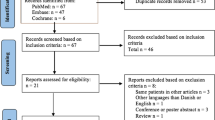Abstract
Introduction and hypothesis
Overactive bladder syndrome with urinary incontinence has a number of treatment options. The National Institute for Health and Care Excellence (NICE) in the UK, the American Urological Association (AUA) and the European Association of Urology (EAU) recommend intradetrusor botulinum neurotoxin A (onabotulinumA) injections in women with proven detrusor overactivity (DO) in whom conservative therapies have failed to improve symptoms. However, the effects of individual onabotulinumA treatments are of short duration and patients usually require further treatments. There is little evidence to inform long-term management strategies using onabotulinumA for DO.
Methods
A retrospective review of patients receiving intradetrusor onabotulinumA injections for DO over a 7-year period was conducted. The primary outcome measures included patient’s subjective reports of symptom change following injections (efficacy) and the duration of symptomatic relief following each treatment.
Results
The analysis included 136 patients. The mean time between patients receiving intradetrusor onabotulinumA and being added to the surgical waiting list for re-treatment varied between 8.5 and 10.4 months for the first five cycles of treatment with the longest time between the third and fourth cycles. This decreased to 5.5 and 5.25 (ANOVA p = 0.015) between the fifth and sixth cycles and between the sixth and seventh cycles of treatment, respectively. Only 19.9 % of patients continued treatment beyond this, with four patients receiving a seventh treatment.
Conclusions
Our results suggest that in patients who respond to onabotulinumA treatment, the duration of response declines after the fifth treatment, suggesting a possible tolerance effect and a subsequent decline in efficacy.



Similar content being viewed by others
References
Haylen BT, de Ridder D, Freeman RM, Swift SE, Berghmans B, Lee J et al (2010) An International Urogynecological Association (IUGA)/International Continence Society (ICS) joint report on the terminology for female pelvic floor dysfunction. Neurourol Urodyn 29(1):4–20
Tubaro A (2004) Defining overactive bladder: epidemiology and burden of disease. Urology 64(6 Suppl 1):2–6
Roxburgh C, Cook J, Dublin N (2007) Anticholinergic drugs versus other medications for overactive bladder syndrome in adults. Cochrane Database Syst Rev 4:CD003190
Duthie JB, Vincent M, Herbison GP, Wilson DI, Wilson D (2011) Botulinum toxin injections for adults with overactive bladder syndrome. Cochrane Database Syst Rev 12:CD005493
Dmochowski R, Sand PK (2007) Botulinum toxin A in the overactive bladder: current status and future directions. BJU Int 99(2):247–262
Nitti VW (2006) Botulinum toxin for the treatment of idiopathic and neurogenic overactive bladder: state of the art. Rev Urol 8(4):198–208
Gormley EA, Lightner DJ, Burgio KL, Chai TC, Clemens JQ, Culkin DJ et al (2012) Diagnosis and treatment of overactive bladder (non-neurogenic) in adults: AUA/SUFU guideline. J Urol 188(6 Suppl):2455–2463
Lucas MG, Bosch RJ, Burkhard FC, Cruz F, Madden TB, Nambiar AK et al (2012) EAU guidelines on assessment and nonsurgical management of urinary incontinence. Eur Urol 62(6):1130–1142
National Collaborating Centre for Women's and Children's Health (UK) (2013) NICE Clinical Guideline No. 171: The management of urinary incontinence in women. London: National Institute for Health and Care Excellence
National Collaborating Centre for Women's and Children's Health (UK) (2006) NICE Clinical Guideline No. 40: The management of urinary incontinence in women. London: National Institute for Health and Care Excellence
Rechberger T, Parsons M, Guard S, Zheng Y, Ginsberg D (2014) Repeat treatments with onabotulinumtoxina provide long-term improvements in symptoms of overactive bladder in female patients with urinary incontinence who are inadequately managed by an anticholinergic. Int Urogynecol J 25(Suppl 1):S1–S240
Grosse J, Kramer G, Stohrer M (2005) Success of repeat detrusor injections of botulinum a toxin in patients with severe neurogenic detrusor overactivity and incontinence. Eur Urol 47(5):653–659
Smith CP, Nishiguchi J, O'Leary M, Yoshimura N, Chancellor MB (2005) Single-institution experience in 110 patients with botulinum toxin A injection into bladder or urethra. Urology 65(1):37–41
Ruffion A, Capelle O, Paparel P, Leriche B, Leriche A, Grise P (2006) What is the optimum dose of type A botulinum toxin for treating neurogenic bladder overactivity? BJU Int 97(5):1030–1034
Karsenty G, Reitz A, Lindemann G, Boy S, Schurch B (2006) Persistence of therapeutic effect after repeated injections of botulinum toxin type A to treat incontinence due to neurogenic detrusor overactivity. Urology 68(6):1193–1197
Reitz A, Denys P, Fermanian C, Schurch B, Comperat E, Chartier-Kastler E (2007) Do repeat intradetrusor botulinum toxin type a injections yield valuable results? Clinical and urodynamic results after five injections in patients with neurogenic detrusor overactivity. Eur Urol 52(6):1729–1735
Del Popolo G, Filocamo MT, Li Marzi V, Macchiarella A, Cecconi F, Lombardi G et al (2008) Neurogenic detrusor overactivity treated with English botulinum toxin A: 8-year experience of one single centre. Eur Urol 53(5):1013–1019
Tincello DG, Owen RK, Slack MC, Mayne C, Toozs-Hobson P, Abrams KR (2014) Efficacy of repeat treatment with onabotulinum toxin for refractory detrusor overactivity: secondary analysis of open label extension of a randomised trial. Int Urogynecol J 25(Suppl 1):S1–S240
Dromerick AW, Edwards DF (2003) Relation of postvoid residual to urinary tract infection during stroke rehabilitation. Arch Phys Med Rehabil 84(9):1369–1372
Brubaker L, Richter HE, Visco A, Mahajan S, Nygaard I, Braun TM et al (2008) Refractory idiopathic urge urinary incontinence and botulinum A injection. J Urol 180(1):217–222
Conflicts of interest
None.
Author information
Authors and Affiliations
Corresponding author
Rights and permissions
About this article
Cite this article
Chohan, N., Hilton, P., Brown, K. et al. Efficacy and duration of response to botulinum neurotoxin A (onabotulinumA) as a treatment for detrusor overactivity in women. Int Urogynecol J 26, 1605–1612 (2015). https://doi.org/10.1007/s00192-015-2751-4
Received:
Accepted:
Published:
Issue Date:
DOI: https://doi.org/10.1007/s00192-015-2751-4




